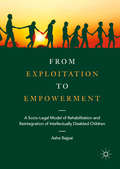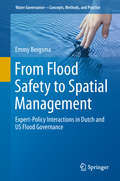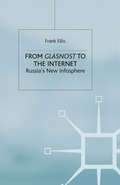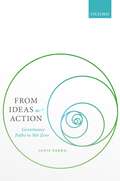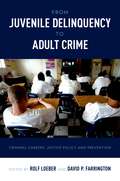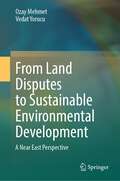- Table View
- List View
From Ethical Review to Responsible Research and Innovation
by Sophie Pellé Bernard ReberThe scientific and technological upheavals of the 20th Century and the questions and difficulties that went along with them (climate change, nuclear energy, GMO, etc.) have increased the necessity of thinking about and formalizing technoscientific progress and its consequences. Expert evaluations and ethics committees today cannot be the only legitimate sources for understanding the social acceptability and desirability of this progress. Responsibility must be shared out on a wider scale, as much in society as in the process of research and innovation projects. This book presents the main works of Responsible Research and Innovation (RRI) from a moral responsibility point of view, for which it calls upon no fewer than 10 understandings to bring out those which are positive and to support an interpretive and combinatory pluralism. In this sense, it demonstrates moral innovation. It analyzes numerous cases and proposes perspectives that are rarely discussed in this emerging field (current practices of ethical evaluation, concerns of the integrity of research, means for participatory technological evaluation, etc.). It contributes to the pledges of RRI, which largely remains theoretically undetermined even though it reorganizes the relationships between science, innovation and society.
From Exploitation to Empowerment: A Socio-Legal Model of Rehabilitation and Reintegration of Intellectually Disabled Children
by Asha BajpaiThis book presents the outcomes of a field action project at the Tata Institute of Social Sciences (TISS). Project Chunauti (English translation: Project Challenge) focused on a group of intellectually disabled, orphan children who were survivors of abuse, exploitation and neglect, and describes their journey toward empowerment. It offers a vision and a reproducible, adaptable model for rehabilitation that can foster the social re-integration of intellectually disabled orphans at institutions. As the implementation of laws is especially important for vulnerable groups, the book also outlines a socio-legal approach that not only impacts the children directly, but can also bring about policy level reforms.Project Chunauti was born out of the need to explore options for these children and to set standards for their care, protection, rehabilitation and social re-integration. The core objectives of the project were to provide support and services, including counseling, education, life skills and vocational skills training, as well as medical and psychiatric support to help them overcome the trauma of abuse and exploitation. Its further goal was to train the staff of state-run homes and state authorities, helping them prepare and implement care plans and rehabilitation, combat child sexual abuse and malnutrition, employ positive disciplining, and better understand disabilities. The book also draws on the Project team’s experiences of rolling out the replication process in Maharashtra. This book highlights the role of the courts, media and other stakeholders in the journey towards empowerment and justice. It is a combination of social-work methods, application and implementation of law and legal advocacy, as well as best practices for protecting children’s rights and developing rehabilitation and re-integration projects for intellectually disabled, orphaned children in India. The interventions detailed here provide a reproducible, adaptable model of intervention for children in institutional care across the country.
From Field to Fork: Food Ethics for Everyone
by Paul B. ThompsonAfter centuries of neglect, the ethics of food are back with a vengeance. Justice for food workers and small farmers has joined the rising tide of concern over the impact of industrial agriculture on food animals and the broader environment, all while a global epidemic of obesity-related diseases threatens to overwhelm modern health systems. An emerging worldwide social movement has turned to local and organic foods, and struggles to exploit widespread concern over the next wave of genetic engineering or nanotechnologies applied to food. Paul B. Thompson's book applies the rigor of philosophy to key topics in the first comprehensive study explore interconnections hidden deep within this welter of issues. Bringing to bear more than thirty years of experience working closely with farmers, agricultural researchers and food system activists, he explores the eclipse of food ethics during the rise of nutritional science, and examines the reasons for its sudden re-emergence in the era of diet-based disease. Thompson discusses social injustice in the food systems of developed economies and shows how we have missed the key insights for understanding food ethics in the developing world. His discussions of animal production and the environmental impact of agriculture break new ground where most philosophers would least expect it. By emphasizing the integration of these issues, Thompson not only brings a comprehensive philosophical approach to moral issues in the production, processing, distribution, and consumption of food -- he introduces a fresh way to think about practical ethics that will have implications in other areas of applied philosophy.
FROM FIELD TO FORK C: Food Ethics for Everyone
by Paul B. ThompsonAfter centuries of neglect, the ethics of food are back with a vengeance. Justice for food workers and small farmers has joined the rising tide of concern over the impact of industrial agriculture on food animals and the broader environment, all while a global epidemic of obesity-related diseases threatens to overwhelm modern health systems. An emerging worldwide social movement has turned to local and organic foods, and struggles to exploit widespread concern over the next wave of genetic engineering or nanotechnologies applied to food. Paul B. Thompson's book applies the rigor of philosophy to key topics in the first comprehensive study explore interconnections hidden deep within this welter of issues. Bringing to bear more than thirty years of experience working closely with farmers, agricultural researchers and food system activists, he explores the eclipse of food ethics during the rise of nutritional science, and examines the reasons for its sudden re-emergence in the era of diet-based disease. Thompson discusses social injustice in the food systems of developed economies and shows how we have missed the key insights for understanding food ethics in the developing world. His discussions of animal production and the environmental impact of agriculture break new ground where most philosophers would least expect it. By emphasizing the integration of these issues, Thompson not only brings a comprehensive philosophical approach to moral issues in the production, processing, distribution, and consumption of food -- he introduces a fresh way to think about practical ethics that will have implications in other areas of applied philosophy.
From Flood Safety to Spatial Management: Expert-Policy Interactions in Dutch and US Flood Governance (Water Governance - Concepts, Methods, and Practice)
by Emmy BergsmaThis book deals with the introduction of a new type of “spatial measures" in flood governance. In contrast to traditional “safety measures" that aim to provide protection against floods by building structural flood defenses such as levees and flood walls, the goal of spatial measures is to reduce the exposure to flood risks by changing the spatial layout of flood-prone areas. By limiting developments and flood-proofing buildings in areas at risk to flooding, investments in structural flood defenses can be circumvented and vulnerabilities reduce. World-wide, spatial measures are gaining attractiveness as a response strategy to increasing flood risks caused by climate change and urbanization. The introduction of spatial measures in flood governance involves more than the simple development of new policies and laws. Research has demonstrated that the implementation of spatial measures can have huge implications for how costs and responsibilities are divided between different levels of governance and between public and private actors, changing the whole organization behind flood governance. Both for the effectiveness and for the legitimacy of spatial flood governance strategies, it is important that these distributive implications are well understood. This book describes the introduction of spatial measures in the context of two very different delta countries: the Netherlands and the United States. In the United States, a spatial flood governance strategy was already developed in de mid-20th century whereas in the Netherlands, a safety paradigm institutionalized over the course of the 20th century and spatial measures have only recently been introduced. By analyzing the science-policy interactions underlying the implementation of spatial measures in both countries, this book shows how under the influence of different types of experts (engineers in the Netherlands and social geographers in the United States) different spatial flood management strategies emerged with different distributive implications, each with its own challenges for effectiveness and legitimacy.
From Formalism to Weak Form: The Architecture and Philosophy of Peter Eisenman
by Stefano CorboPeter Eisenman is one of the most controversial protagonists of the architectural scene, who is known as much for his theoretical essays as he is for his architecture. While much has been written about his built works and his philosophies, most books focus on one or the other aspect. By structuring this volume around the concept of form, Stefano Corbo links together Eisenman’s architecture with his theory. From Formalism to Weak Form: The Architecture and Philosophy of Peter Eisenman argues that form is the sphere of mediation between our body, our inner world and the exterior world and, as such, it enables connections to be made between philosophy and architecture. From the start of his career on, Eisenman has been deeply interested in the problem of form in architecture and has constantly challenged the classical concept of it. For him, form is not simply a cognitive tool that determines a physical structure, which discriminates all that is active from what is passive, what is inside from what is outside. He has always tried to connect his own work with the cultural manifestations of the time: firstly under the influence of Colin Rowe and his formalist studies; secondly, by re-interpreting Chomsky’s linguistic theories; in the 80’s, by collaborating with Derrida and his de-constructivist approach; more recently,by discovering Henri Bergson's idea of Time. These different moments underline different phases, different projects, different programmatic manifestos; and above all, an evolving notion of form. Taking a multi-disciplinary approach based on the intersections between architecture and philosophy, this book investigates all these definitions and, in doing so, provides new insights into and a deeper understanding of the complexity of Eisenman’s work.
From Formalism to Weak Form: The Architecture and Philosophy of Peter Eisenman
by Stefano CorboPeter Eisenman is one of the most controversial protagonists of the architectural scene, who is known as much for his theoretical essays as he is for his architecture. While much has been written about his built works and his philosophies, most books focus on one or the other aspect. By structuring this volume around the concept of form, Stefano Corbo links together Eisenman’s architecture with his theory. From Formalism to Weak Form: The Architecture and Philosophy of Peter Eisenman argues that form is the sphere of mediation between our body, our inner world and the exterior world and, as such, it enables connections to be made between philosophy and architecture. From the start of his career on, Eisenman has been deeply interested in the problem of form in architecture and has constantly challenged the classical concept of it. For him, form is not simply a cognitive tool that determines a physical structure, which discriminates all that is active from what is passive, what is inside from what is outside. He has always tried to connect his own work with the cultural manifestations of the time: firstly under the influence of Colin Rowe and his formalist studies; secondly, by re-interpreting Chomsky’s linguistic theories; in the 80’s, by collaborating with Derrida and his de-constructivist approach; more recently,by discovering Henri Bergson's idea of Time. These different moments underline different phases, different projects, different programmatic manifestos; and above all, an evolving notion of form. Taking a multi-disciplinary approach based on the intersections between architecture and philosophy, this book investigates all these definitions and, in doing so, provides new insights into and a deeper understanding of the complexity of Eisenman’s work.
From Glasnost to the Internet: Russia's New Infosphere
by Frank EllisThe Soviet collapse of 1991 - the Great August liberation - demonstrated the total exhaustion of Marxist-Leninist agitation and propaganda. It was no longer possible to live on slogans. The failure of Soviet agitprop is also the failure of Soviet censorship the latter being a unique institution in anti-thought. In From Glasnost to the Internet Ellis analyses the consequences of censorship, before tackling the media legislation of the Russian Federation and the new dangers to the free flow of information emerging both within and outside the Russian Federation.
From Higher Aims to Hired Hands: The Social Transformation of American Business Schools and the Unfulfilled Promise of Management as a Profession
by Rakesh KhuranaIs management a profession? Should it be? Can it be? This major work of social and intellectual history reveals how such questions have driven business education and shaped American management and society for more than a century. The book is also a call for reform. Rakesh Khurana shows that university-based business schools were founded to train a professional class of managers in the mold of doctors and lawyers but have effectively retreated from that goal, leaving a gaping moral hole at the center of business education and perhaps in management itself. Khurana begins in the late nineteenth century, when members of an emerging managerial elite, seeking social status to match the wealth and power they had accrued, began working with major universities to establish graduate business education programs paralleling those for medicine and law. Constituting business as a profession, however, required codifying the knowledge relevant for practitioners and developing enforceable standards of conduct. Khurana, drawing on a rich set of archival material from business schools, foundations, and academic associations, traces how business educators confronted these challenges with varying strategies during the Progressive era and the Depression, the postwar boom years, and recent decades of freewheeling capitalism. Today, Khurana argues, business schools have largely capitulated in the battle for professionalism and have become merely purveyors of a product, the MBA, with students treated as consumers. Professional and moral ideals that once animated and inspired business schools have been conquered by a perspective that managers are merely agents of shareholders, beholden only to the cause of share profits. According to Khurana, we should not thus be surprised at the rise of corporate malfeasance. The time has come, he concludes, to rejuvenate intellectually and morally the training of our future business leaders.
From Higher Aims to Hired Hands: The Social Transformation of American Business Schools and the Unfulfilled Promise of Management as a Profession
by Rakesh KhuranaIs management a profession? Should it be? Can it be? This major work of social and intellectual history reveals how such questions have driven business education and shaped American management and society for more than a century. The book is also a call for reform. Rakesh Khurana shows that university-based business schools were founded to train a professional class of managers in the mold of doctors and lawyers but have effectively retreated from that goal, leaving a gaping moral hole at the center of business education and perhaps in management itself. Khurana begins in the late nineteenth century, when members of an emerging managerial elite, seeking social status to match the wealth and power they had accrued, began working with major universities to establish graduate business education programs paralleling those for medicine and law. Constituting business as a profession, however, required codifying the knowledge relevant for practitioners and developing enforceable standards of conduct. Khurana, drawing on a rich set of archival material from business schools, foundations, and academic associations, traces how business educators confronted these challenges with varying strategies during the Progressive era and the Depression, the postwar boom years, and recent decades of freewheeling capitalism. Today, Khurana argues, business schools have largely capitulated in the battle for professionalism and have become merely purveyors of a product, the MBA, with students treated as consumers. Professional and moral ideals that once animated and inspired business schools have been conquered by a perspective that managers are merely agents of shareholders, beholden only to the cause of share profits. According to Khurana, we should not thus be surprised at the rise of corporate malfeasance. The time has come, he concludes, to rejuvenate intellectually and morally the training of our future business leaders.
From House of Lords to Supreme Court: Judges, Jurists and the Process of Judging
by James Lee2009 saw the centenary of the Society of Legal Scholars and the transition from the House of Lords to the new Supreme Court. The papers presented in this volume arise from a seminar organised jointly by the Society of Legal Scholars and the University of Birmingham to celebrate and consider these historic events. The papers examine judicial reasoning and the interaction between judges, academics and the professions in their shared task of interpretative development of the law. The volume gathers leading authorities on the House of Lords in its judicial capacity together with academics whose specialisms lie in particular fields of law, including tort, human rights, restitution, European law and private international law. The relationship between judge and jurist is, therefore, investigated from a variety of perspectives and with reference to different jurisdictions. The aim of the volume is to reflect upon the jurisprudence of the House of Lords and to consider the prospects for judging in the new Supreme Court.
From Human-Centered Design to Human-Centered Society: Creatively Balancing Business Innovation and Societal Exploitation
by William B. RouseA human-centered society creatively balances investments in sources of innovation, while also governing in a manner that eventually limits exploitation by originators once innovations have proven their value in the marketplace, broadly defined to include both private and public constituencies. The desired balance requires society to invest in constituencies to be able to create innovations that provide current and future collective benefits, while also assuring society provides laws, courts, police, and military to protect individual rights to life, liberty, and the pursuit of happiness. The balance addresses collectivism vs. individualism. Collectivism emphasizes the importance of the community. Individualism, in contrast, is focused on the rights and concerns of each person. Unity and selflessness or altruism are valued traits in collectivist cultures; independence and personal identity are central in individualistic cultures. Collectivists can become so focused on collective benefits that they ignore sources and opportunities for innovation. Individualists can tend to invest themselves, almost irrationally, in ideas and visions, many of which will fail, but some will transform society. Collectivists need to let individualists exploit their successful ideas. Individualists need to eventually accept the need to provide collective benefits. This book addresses the inherent tension underlying the pursuit of this balance. It has played a central role in society at least since the Industrial Revolution (1760–1840). Thus, the story of this tension, how it regularly emerges, and how it is repeatedly resolved, for better or worse, is almost a couple of centuries old. Creating a human-centered society can be enabled by creatively enabling this balance. Explicitly recognizing the need for this balance is a key success factor. This book draws upon extensive experiences within the domains of transportation and defense, computing and communications, the Internet and social media, health and wellness, and energy and climate. Balancing innovation and exploitation takes varying forms in these different domains. Nevertheless, the underlying patterns and practices are sufficiently similar to enable important generalizations.
From Human-Centered Design to Human-Centered Society: Creatively Balancing Business Innovation and Societal Exploitation
by William B. RouseA human-centered society creatively balances investments in sources of innovation, while also governing in a manner that eventually limits exploitation by originators once innovations have proven their value in the marketplace, broadly defined to include both private and public constituencies. The desired balance requires society to invest in constituencies to be able to create innovations that provide current and future collective benefits, while also assuring society provides laws, courts, police, and military to protect individual rights to life, liberty, and the pursuit of happiness. The balance addresses collectivism vs. individualism. Collectivism emphasizes the importance of the community. Individualism, in contrast, is focused on the rights and concerns of each person. Unity and selflessness or altruism are valued traits in collectivist cultures; independence and personal identity are central in individualistic cultures. Collectivists can become so focused on collective benefits that they ignore sources and opportunities for innovation. Individualists can tend to invest themselves, almost irrationally, in ideas and visions, many of which will fail, but some will transform society. Collectivists need to let individualists exploit their successful ideas. Individualists need to eventually accept the need to provide collective benefits. This book addresses the inherent tension underlying the pursuit of this balance. It has played a central role in society at least since the Industrial Revolution (1760–1840). Thus, the story of this tension, how it regularly emerges, and how it is repeatedly resolved, for better or worse, is almost a couple of centuries old. Creating a human-centered society can be enabled by creatively enabling this balance. Explicitly recognizing the need for this balance is a key success factor. This book draws upon extensive experiences within the domains of transportation and defense, computing and communications, the Internet and social media, health and wellness, and energy and climate. Balancing innovation and exploitation takes varying forms in these different domains. Nevertheless, the underlying patterns and practices are sufficiently similar to enable important generalizations.
From Ideas to Action: Governance Paths to Net Zero
by Janis SarraThis book offers a guide, for companies, pension funds, asset managers, and other institutional investors, on how to commence the legal, governance, and financial strategies needed for effective climate mitigation and adaptation, and to help distribute the economic benefits of these actions to their stakeholders. It takes the reader from ideas to action, from first steps to a more meaningful contribution to the move towards a net zero carbon world. It can serve as a helpful guide to everyone implicated in a corporation's activities - employees, pensioners, consumers, banks and other lenders, policymakers, and community members. It offers insights into what we should be expecting, and asking, of these fiduciaries who have taken responsibility for effectively managing our savings, our retirement funds, our investments, and our tax dollars.
From Ideas to Action: Governance Paths to Net Zero
by Janis SarraThis book offers a guide, for companies, pension funds, asset managers, and other institutional investors, on how to commence the legal, governance, and financial strategies needed for effective climate mitigation and adaptation, and to help distribute the economic benefits of these actions to their stakeholders. It takes the reader from ideas to action, from first steps to a more meaningful contribution to the move towards a net zero carbon world. It can serve as a helpful guide to everyone implicated in a corporation's activities - employees, pensioners, consumers, banks and other lenders, policymakers, and community members. It offers insights into what we should be expecting, and asking, of these fiduciaries who have taken responsibility for effectively managing our savings, our retirement funds, our investments, and our tax dollars.
From International to Federal Market: The Changing Structure of European Law
by Robert SchützeWhat are the different market types that shape the European Union's internal market? Schütze proposes three models that assist in explaining the transitions in the structure of the EU internal market. The international model demands that each state limits its external sovereignty, while retaining internal sovereignty over its national market. The federal model declares that within a "common market" states must lose a part of their internal sovereignty, and in accordance with the principle of "home state" control, goods are entitled to be sold freely on a "foreign" market in compliance with home state law. The national model proposes that the trade restrictions above a legislative or judicial Union standard should be removed. Schütze's book analyses the changing structure of European law in relation to the European internal market. The General Part starts out by offering a historical analysis of the relationship between international law and market coordination up to the twentieth century but also provides an in-depth analysis of the constitutional principles which controlled the "integration" of the US "common market". The Special Part then specifically addresses the decline of the international model in relation to the EU internal market and the corresponding rise of a federal market philosophy after Cassis de Dijon. The final chapter explores the exceptional constitutional principles that apply to fiscal matters. This is the second volume in Schütze's trilogy on the "Changing Structure of European Law". Exploring the changing structure of negative integration in the past 60 years, the book complements his previous volume "From Dual to Cooperative Federalism" which analysed the evolving structure of positive integration. A third volume will finally explore the formal constitutional aspects in the evolution of the European Union into a federal union of States.
From International to Federal Market: The Changing Structure of European Law
by Robert SchützeWhat are the different market types that shape the European Union's internal market? Schütze proposes three models that assist in explaining the transitions in the structure of the EU internal market. The international model demands that each state limits its external sovereignty, while retaining internal sovereignty over its national market. The federal model declares that within a "common market" states must lose a part of their internal sovereignty, and in accordance with the principle of "home state" control, goods are entitled to be sold freely on a "foreign" market in compliance with home state law. The national model proposes that the trade restrictions above a legislative or judicial Union standard should be removed. Schütze's book analyses the changing structure of European law in relation to the European internal market. The General Part starts out by offering a historical analysis of the relationship between international law and market coordination up to the twentieth century but also provides an in-depth analysis of the constitutional principles which controlled the "integration" of the US "common market". The Special Part then specifically addresses the decline of the international model in relation to the EU internal market and the corresponding rise of a federal market philosophy after Cassis de Dijon. The final chapter explores the exceptional constitutional principles that apply to fiscal matters. This is the second volume in Schütze's trilogy on the "Changing Structure of European Law". Exploring the changing structure of negative integration in the past 60 years, the book complements his previous volume "From Dual to Cooperative Federalism" which analysed the evolving structure of positive integration. A third volume will finally explore the formal constitutional aspects in the evolution of the European Union into a federal union of States.
From Invention to Patent: A Scientist and Engineer's Guide
by Steven H. VoldmanInvention and patents continues to be an important issue in technology and our global economy. Invention and Patenting provides a clear picture of how to be a prolific inventor, to understand patents, and the patent process. It provides an illuminating insight into the writing of invention disclosures to patents from the submission process to final drafts. The book shows how to communicate effectively with patent lawyers and patent examiners, teaching the language of “legalese.” This book is unique in covering both the early invention process to final patent drafting to provide high quality patents in technologies. Key features include: How to become an inventor, how to invent, to what is invention; How to write an invention disclosure to writing a patent; Examples of utility, design, and plant patents; How to prepare the background section, brief listing of figures, detailed description of the invention, claims, abstract to artwork; Using patent search engines; Writing independent and dependent claims; Analyzing office actions of the US and European patent offices; How to write an office action response and amending claims; and, Examples of Office Action responses, preliminary amendments, to notice of allowance response; Invention and Patenting is the first book by an engineer and inventor from a technologist’s point of view. It is an essential reference for engineers and inventors. It is also useful for graduate and undergraduate students in technology and the sciences.
From Invention to Patent: A Scientist and Engineer's Guide
by Steven H. VoldmanInvention and patents continues to be an important issue in technology and our global economy. Invention and Patenting provides a clear picture of how to be a prolific inventor, to understand patents, and the patent process. It provides an illuminating insight into the writing of invention disclosures to patents from the submission process to final drafts. The book shows how to communicate effectively with patent lawyers and patent examiners, teaching the language of “legalese.” This book is unique in covering both the early invention process to final patent drafting to provide high quality patents in technologies. Key features include: How to become an inventor, how to invent, to what is invention; How to write an invention disclosure to writing a patent; Examples of utility, design, and plant patents; How to prepare the background section, brief listing of figures, detailed description of the invention, claims, abstract to artwork; Using patent search engines; Writing independent and dependent claims; Analyzing office actions of the US and European patent offices; How to write an office action response and amending claims; and, Examples of Office Action responses, preliminary amendments, to notice of allowance response; Invention and Patenting is the first book by an engineer and inventor from a technologist’s point of view. It is an essential reference for engineers and inventors. It is also useful for graduate and undergraduate students in technology and the sciences.
From Jim Crow to Civil Rights: The Supreme Court and the Struggle for Racial Equality
by Michael J. KlarmanA monumental investigation of the Supreme Court's rulings on race, From Jim Crow To Civil Rights spells out in compelling detail the political and social context within which the Supreme Court Justices operate and the consequences of their decisions for American race relations. In a highly provocative interpretation of the decision's connection to the civil rights movement, Klarman argues that Brown was more important for mobilizing southern white opposition to racial change than for encouraging direct-action protest. Brown unquestioningly had a significant impact--it brought race issues to public attention and it mobilized supporters of the ruling. It also, however, energized the opposition. In this authoritative account of constitutional law concerning race, Michael Klarman details, in the richest and most thorough discussion to date, how and whether Supreme Court decisions do, in fact, matter.
From Jim Crow to Civil Rights: The Supreme Court and the Struggle for Racial Equality
by Michael J. KlarmanA monumental investigation of the Supreme Court's rulings on race, From Jim Crow To Civil Rights spells out in compelling detail the political and social context within which the Supreme Court Justices operate and the consequences of their decisions for American race relations. In a highly provocative interpretation of the decision's connection to the civil rights movement, Klarman argues that Brown was more important for mobilizing southern white opposition to racial change than for encouraging direct-action protest. Brown unquestioningly had a significant impact--it brought race issues to public attention and it mobilized supporters of the ruling. It also, however, energized the opposition. In this authoritative account of constitutional law concerning race, Michael Klarman details, in the richest and most thorough discussion to date, how and whether Supreme Court decisions do, in fact, matter.
From Justice to Protection: A Proposal for Public Health Bioethics (SpringerBriefs in Public Health)
by Miguel KottowIn most developed countries, the epidemiological disease profile has changed from infectious to degenerative, causing major alterations in epidemiological thinking and public health policies. Less developed nations have to deal with a more complex situation, because social disparities create highly unequal health conditions, the affluent being afflicted by degenerative conditions, whereas the poorer social segments continue to suffer infectious diseases, but also begin to feel the effects of chronic illness. At the turn of the 21st century, equity in health care is not being served, and social justice has lost credibility as a conceptual driving force of public health policies. Rampant injustice confirms that theories, reality and suggested practices of just social orders are flawed, leaving the needy without help or hope in a world of flagrant ethical inadequacy. And yet, mainstream bioethics loses meaning and relevance as it clings to the principle of justice and hails such concepts as global justice and universal health-care equity, misleadingly focusing on justice as a desideratum. This book pleads for an urgent turn towards directly addressing injustice as a reality that requires pressingly needed arguments and proposals to inspire realistic public health policies and programs based on an ethics of protection. Ever since Hobbes, all shades of political philosophy accept that the basic obligation of the ruling power is to protect its subjects. The ethics of protection emphasizes aiding the needy and the disempowered in obtaining access to basic goods and services related to health-care. Public health is called upon to fulfill protective obligations to guarantee disease prevention and medical services to the population, taking special care to safeguard those unable to cover their health-care needs in market-oriented medical services and institutions. The bioethics of protection developed in this text presents specific and explicit guide-lines to assure that protective public health actions be efficacious (problem-solving), efficient (sustainable cost/benefit relation) and ethically sound (respecting human rights and the common weal). These guide-lines are designed to give ethical support and justification to public health policies even when they require some unavoidable limitations of individual autonomy to promote social health benefits.
From Juvenile Delinquency to Adult Crime: Criminal Careers, Justice Policy, and Prevention
by Rolf Loeber David P. FarringtonWhat makes a juvenile delinquent develop into an adult criminal? Edited by two leading authorities in the fields of psychology and criminology, Transitions from Juvenile Delinquency to Adult Crime examines why the period of transition to adulthood is important and how it can be better understood and addressed both inside and outside of the justice system. With serious scholarly analysis and practical policy proposals, Transitions from Juvenile Delinquency to Adult Crime addresses what can be done to ensure that today's juvenile delinquents do not become tomorrow's adult criminals.
From Land Disputes to Sustainable Environmental Development: A Near East Perspective
by Ozay Mehmet Vedat YorucuThis book is written to transform land disputes toward win-win outcomes utilizing the latest sustainable development theory. Land has always been a source of conflict, a contest of competing homelands and ideologies, but it can also act as an agency of peace-making, promoting economic and social development. This dualism will be the theme of this book as there is a dearth of studies exclusively focused on land. The book's coverage is comprehensive, examining land and property disputes with case studies in modern times along with a problem-solving approach utilizing such economic theorems as Location and Growth Poles theories. The UN’s Sustainable Development Goals will be used as our over-arching framework. The overall aim of the book is to transform land disputes toward win-win outcomes utilizing latest sustainable development theory.
From Land Ownership to Landed Commons: Social Innovation in the Commoning of Scarce Land Resources
This book offers a comprehensive survey of the history of thought and practice of commoning of scarce land resources. Presenting a refreshing theoretical and historical perspective, it explores how social relations, ethics, and agencies have affected the building and development – but also the decline – of Landed Commons. Bringing together expert contributors from across the globe and investigating in depth three case studies, the book addresses how people have acquired or lost their rights to use land, the institutionalization processes that have shaped or destroyed these rights, and how Landed Commons can be built, developed, and sustained in a socially innovative way. Using concepts from the Théorie des Cités, it demonstrates how mutual aid-based action research can be seen as the way forward for communities to build and maintain equitable and sustainable human-land relations in Landed Commons.Academics, researchers, and students in regulation and governance, politics and public policy, human geography, social work, law, and economics will benefit from this in-depth exploration of the human relevance of commoning in contemporary neo-liberal times. Commoning activists, government officials, and practitioners will equally find this to be an invaluable read.

